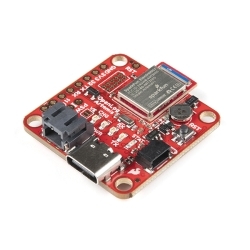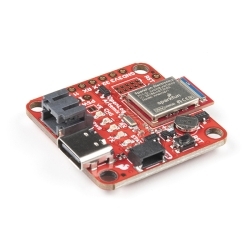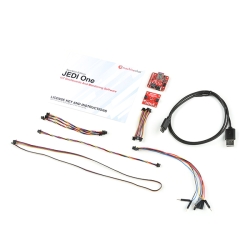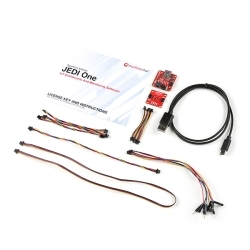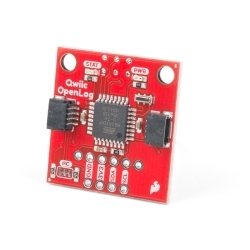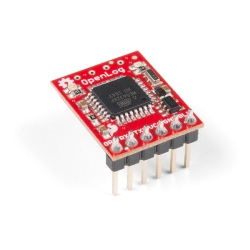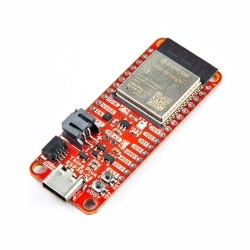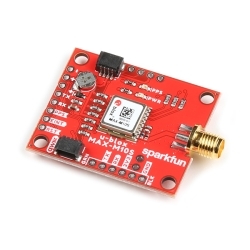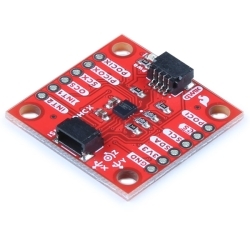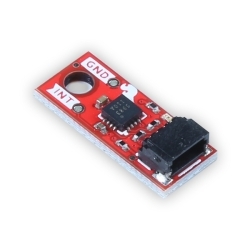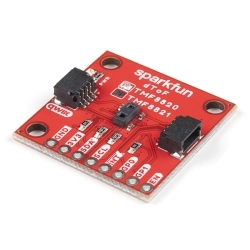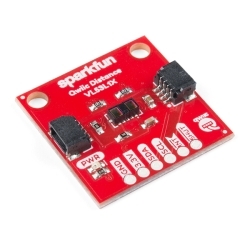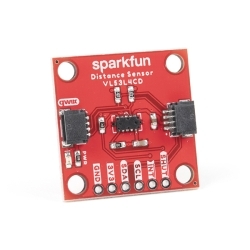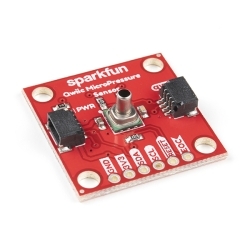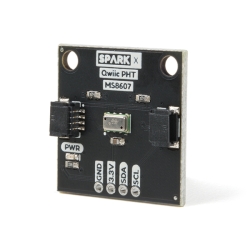SparkFun DataLogger IoT - 9DoF
The SparkFun DataLogger IoT - 9DoF comes preprogrammed to automatically log IMU, GPS, and various pressure, humidity, and distance sensors.
Helpful Documentation
Product Overview
The SparkFun DataLogger IoT - 9DoF is a data logger that comes preprogrammed to automatically log IMU, GPS, and various pressure, humidity, and distance sensors. All without writing a single line of code! The DataLogger automatically detects, configures, and logs Qwiic sensors. It was specifically designed for users who just need to capture a lot of data to a CSV or JSON file and get back to their larger project. Save the data to a microSD card or send it wirelessly to your preferred Internet of Things (IoT) service!
Included on every DataLogger IoT is an IMU for built-in logging of a triple-axis accelerometer, gyro, and magnetometer. Whereas the original 9DOF Razor used the old MPU-9250, the DataLogger IoT uses the ISM330DHCX from STMicroelectronics and MMC5983MA from MEMSIC. Simply power up the DataLogger IoT, configure the board to record readings from supported devices, and begin logging! Data can be time-stamped when the time is synced to NTP, GNSS, or RTC.
The DataLogger IoT is highly configurable over an easy-to-use serial interface. Simply plug in a USB-C cable and open a serial terminal at 115200 baud. The logging output is automatically streamed to both the terminal and the microSD card. Pressing any key in the terminal window will open the configuration menu.
The DataLogger IoT - 9DoF automatically scans, detects, configures, and logs various Qwiic sensors plugged into the board (No soldering! No programming!). Currently, auto-detection is supported on the following Qwiic products (with the exception of the ISM330DHCX and MMC5983 which is built-in on the SPI port):
- Any u-Blox GNSS Modules (Lat/Long, Altitude, Velocity, SIV, Time, Date) such as:
- ZED-F9P 1cm High Precision GPS
- NEO-M8P-2 2.5cm High Precision GPS
- SAM-M10Q 1.5m GPS
- SAM-M8Q 1.5m 72 Channel GPS
- ZOE-M8Q 1.5m Compact GPS
- NEO-M9N 1.5m GPS
- MAX-M10S 1.5m Ultra-Low Power GPS
- Inertial Measurement Unit (Accelerometer and Gyro):
- ISM330DHCX IMU (Built-in for the 9DoF version via SPI)
- Magnetometer:
- MMC5983 (Built-in for the 9DoF version via SPI)
- Distance:
- TMF8820 dToF Imager
- TMF8821 dToF Imager
- VCNL4040 Proximity and Lux
- VL53L1X Distance - 4 Meter
- VL53L4 Distance - 1.3 Meter
- VL53L5 ToF Imager
- STHS34PF80 Human Presence and Motion and Mini
- Pressure, Altitude, Humidity, and Temperature Data:
- BME280 Atmospheric
- LPS25HB Absolute Pressure
- MPR Series - MPRLS0025PA00001A MicroPressure
- MS8607 Pressure, Humidity, and Temperature
- MS5637 Barometric Pressure and Temperature
- AHT20 Humidity and Temperature
- SHTC3 Humidity and Temperature
- SDP31 Differential Pressure
- BMP384 Pressure and Temperature
- BMP581 Pressure and Temperature
- ENS160/BME280 Environmental Combo
- Air Quality and Environmental Sensors:
- CCS811 Air Quality (CO2 and VOC)
- ENS160 Indoor Air Quality Sensor (AQI, eCO2, TVOC)
- PASCO2V01 Photoacoustic Spectroscopy (CO2)
- SGP30 Air Quality (TVOC, CO2, H2, Ethanol)
- SGP40 Air Quality (VOC, Humidity, Temperature)
- SCD30 CO2, Humidity, and Temperature
- SCD40 CO2, Humidity, and Temperature
- BME680 Air Quality (Pressure, Humidity, Temperature, Gas, VOCs)
- BME688 Air Quality (Pressure, Humidity, Temperature, Gas, VOCs, VSC, CO, Gas)
- FS3000 Air Velocity
- SEN54 Environmental Sensor Node (Particle, VOC, Humidity, and Temperature)
- STC31 CO2 and Temperature sensor
- VEML6075 UV
- VEML7700 Ambient Light and Lux
- OPT4048DTSR Tristimulus Color and Mini
- AS7265x Triad Spectroscopy
- Temperature:
- AMG8833 Grid-EYE Infrared Array
- MCP9600 Thermocouple Amplifier
- PT100 ADS122C04 PR Temperature
- TMP117 High Precision Temperature
- Power:
- ACS37800 Power Meter
- MAX17048 Li-Po Battery Fuel Gauge (Built-in via I2C)
- Real-Time Clock:
- RV8803 RTC Module
- NFC/RFID:
- ST25DVxxKC Dynamic NFC/RFID Tag
- Biometric Sensors:
- Biomedical Sensor Hub (MAX32664) with Pulse Oximeter and Heart Rate (MAX30101)
- Weight:
- NAU7802 Qwiic Scale Load Cell Amplifier
- Miscellaneous:
- Qwiic Button
- Qwiic Twist RGB Rotary Encoder
- Analog Voltage:
- ADS1015 12-bit 4-channel Differential ADC
- ADS122C04 24-bit Differential ADC found on the PT100
The DataLogger IoT - 9DoF uses common microSD cards to record clear text, comma separated (i.e. CSV), or JavaScript Object Notation (JSON) files. You probably already have a microSD card laying around but if you need any additional units, see the related items. Note that the DataLogger IoT is not able to use any size microSD card. The DataLogger IoT supports 4-bit SDIO with microSD cards formatted as FAT32 as well as the older FAT16 (i.e. FAT) formats up to 32GB.
Low-power logging is supported. The DataLogger IoT can be configured to take readings at about 26 times a second with the default sensors turned on, or as slow as 1 reading every 24 hours. You choose! The DataLogger IoT has built-in LiPo charging set at 500mA/hr. When sleep mode is enabled, the resulting sleep current is approximately 200µA.
With a 2.4GHz WiFi connection, you can also send data to the cloud! The following IoT services are supported:
- MQTT Client
- MQTT Secure Client
- AWS IoT
- ThingSpeak MQTT
- Azure IoT
- HTTP IoT
- MachineChat
- Arduino Cloud
New features are constantly being added so we've developed two methods of updating the firmware on your DataLogger IoT! If you have a microSD card, you can download the firmware binary to the memory card and update the board through the configuration menu. If you have a WiFi connection, you can also update the firmware over the air using the configuration menu! No need to install Arduino or a bunch of libraries.
Features & Specs
ESP32-WROOM-32E Module:
- Integrated 802.11b/g/n WiFi 2.4GHz transceiver
- Configurable via CH340C
Power Specs:
- 3.3V to 6.0V (via VIN)
- 5V with USB (via 5V or USB type C)
- 3.6V to 4.2V with LiPo battery (via BATT or 2-pin JST)
- Built-in MCP73831 single cell LiPo charger
- Minimum 500mA charge rate
- 3.3V (via I2C)
- MAX17048 LiPo Fuel Gauge
Ports
- 1x USB type C
- 1x JST style connector for LiPo battery
- 2x Qwiic enabled I2C
- 1x microSD socket
- Support for 4-bit SDIO and microSD cards formatted to FAT32
LEDs
- Charge (CHG)
- Status (STAT)
- 1-Wire B3DQ3BRG Addressable RGB
Jumpers
- Measure
- RGB LED
- Status LED
- Charge LED
- I2C pull-up resistors
- USB Shield
Buttons
- Reset
- Boot
Dimensions: 1.66in. x 2.00in.
Weight: 10.65g
Customer Reviews

Stock and Customer Discounts
Available Discounts
- $75.95 | 10+ units
- $71.96 | 25+ units
- $67.96 | 100+ units

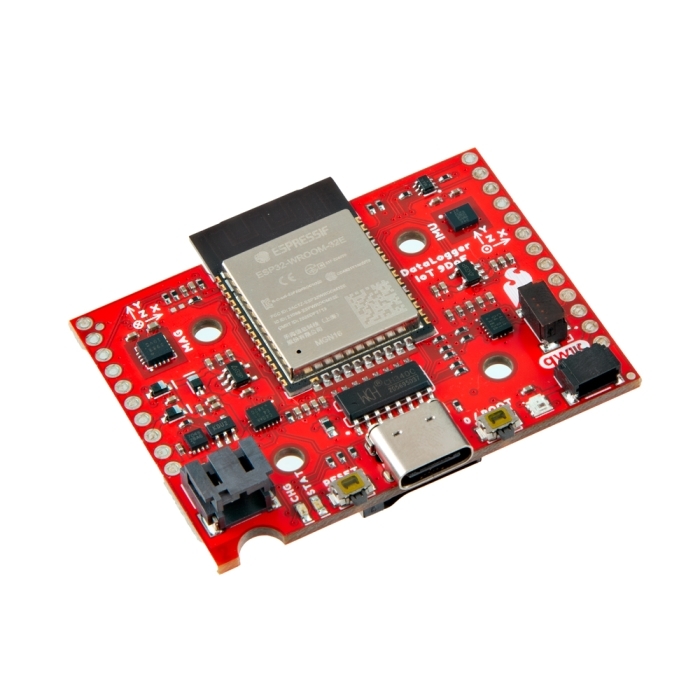
 Hookup Guide
Hookup Guide Schematic
Schematic
